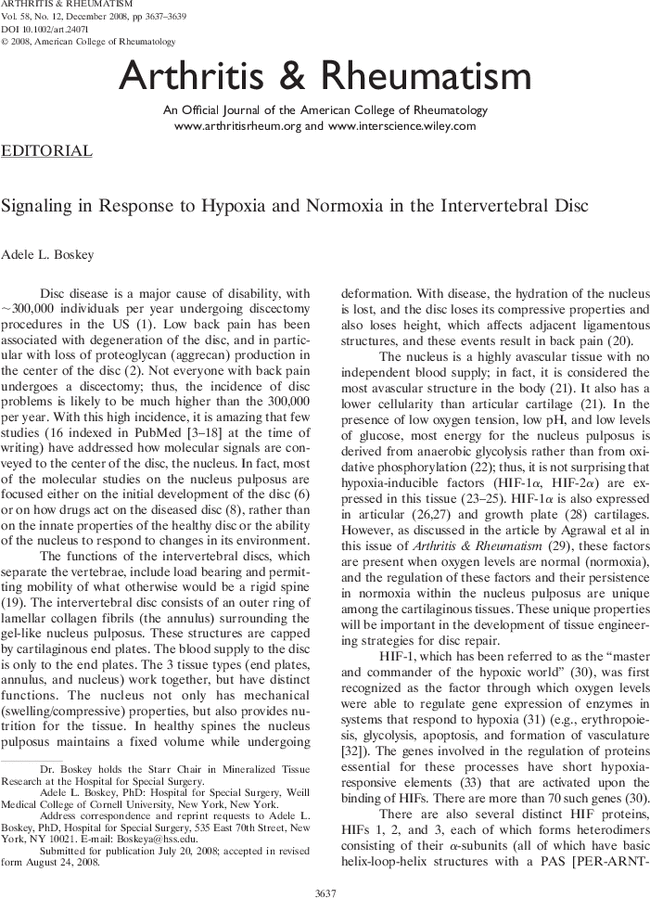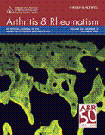Editorial
Signaling in response to hypoxia and normoxia in the intervertebral disc
Adele L. Boskey,
Corresponding Author
Adele L. Boskey
Hospital for Special Surgery, Weill Medical College of Cornell University, New York, New York
Dr. Boskey holds the Starr Chair in Mineralized Tissue Research at the Hospital for Special Surgery.
Hospital for Special Surgery, 535 East 70th Street, New York, NY 10021Search for more papers by this authorAdele L. Boskey,
Corresponding Author
Adele L. Boskey
Hospital for Special Surgery, Weill Medical College of Cornell University, New York, New York
Dr. Boskey holds the Starr Chair in Mineralized Tissue Research at the Hospital for Special Surgery.
Hospital for Special Surgery, 535 East 70th Street, New York, NY 10021Search for more papers by this author
REFERENCES
- 1 United States Bone and Joint Decade. The burden of musculoskeletal diseases in the United States. Rosemont (IL): American Academy of Orthopaedic Surgeons; 2008. p 32.
- 2 Le Maitre CL, Pockert A, Buttle DJ, Freemont AJ, Hoyland JA. Matrix synthesis and degradation in human intervertebral disc degeneration. Biochem Soc Trans 2007; 35: 652–5.
- 3 Okuda S, Myoui A, Ariga K, Nakase T, Yonenobu K, Yoshikawa H. Mechanisms of age-related decline in insulin-like growth factor-I dependent proteoglycan synthesis in rat intervertebral disc cells. Spine 2000; 26: 2421–6.
- 4 Pritchard S, Erickson GR, Guilak F. Hyperosmotically induced volume change and calcium signaling in intervertebral disk cells: the role of the actin cytoskeleton. Biophys J 2002; 83: 2502–10.
- 5 Risbud MV, Fertala J, Vresilovic EJ, Albert TJ, Shapiro IM. Nucleus pulposus cells upregulate PI3K/Akt and MEK/ERK signaling pathways under hypoxic conditions and resist apoptosis induced by serum withdrawal. Spine 2005; 30: 882–9.
- 6 DiPaola CP, Farmer JC, Manova K, Niswander LA. Molecular signaling in intervertebral disk development. J Orthop Res 2005; 23: 1112–9.
- 7 Risbud MV, Guttapalli A, Albert TJ, Shapiro IM. Hypoxia activates MAPK activity in rat nucleus pulposus cells: regulation of integrin expression and cell survival. Spine 2005; 30: 2503–9.
- 8 Yoon ST, Patel NM. Molecular therapy of the intervertebral disc. Eur Spine J 2006; 15 Suppl 3: S379–88.
- 9 Seguin CA, Bojarski M, Pilliar RM, Roughley PJ, Kandel RA. Differential regulation of matrix degrading enzymes in a TNFα-induced model of nucleus pulposus tissue degeneration. Matrix Biol 2006; 25: 409–18.
- 10 Uchiyama Y, Cheng CC, Danielson KG, Mochida J, Albert TJ, Shapiro IM, et al. Expression of acid-sensing ion channel 3 (ASIC3) in nucleus pulposus cells of the intervertebral disc is regulated by p75NTR and ERK signaling. J Bone Miner Res 2007; 22: 1996–2006.
- 11 Pratsinis H, Kletsas D. PDGF, bFGF and IGF-I stimulate the proliferation of intervertebral disc cells in vitro via the activation of the ERK and Akt signaling pathways. Eur Spine J 2007; 16: 1858–66.
- 12 Tsai TT, Guttapalli A, Oguz E, Chen LH, Vaccaro AR, Albert TJ, et al. Fibroblast growth factor-2 maintains the differentiation potential of nucleus pulposus cells in vitro: implications for cell-based transplantation therapy. Spine 2007; 32: 495–502.
- 13 Tsai TT, Guttapalli A, Agrawal A, Albert TJ, Shapiro IM, Risbud MV. MEK/ERK signaling controls osmoregulation of nucleus pulposus cells of the intervertebral disc by transactivation of TonEBP/OREBP. J Bone Miner Res 2007; 22: 965–74.
- 14 Studer RK, Aboka AM, Gilbertson LG, Georgescu H, Sowa G, Vo N, et al. p38 MAPK inhibition in nucleus pulposus cells: a potential target for treating intervertebral disc degeneration. Spine 2007; 32: 2827–33.
- 15 Zhang L, Niu T, Yang SY, Lu Z, Chen B. The occurrence and regional distribution of DR4 on herniated disc cells: a potential apoptosis pathway in lumbar intervertebral disc. Spine 2008; 33: 422–7.
- 16 Seguin CA, Pilliar RM, Madri JA, Kandel RA. TNF-α induces MMP2 gelatinase activity and MT1-MMP expression in an in vitro model of nucleus pulposus tissue degeneration. Spine 2008; 33: 356–65.
- 17 Studer RK, Gilbertson LG, Georgescu H, Sowa G, Vo N, Kang JD. p38 MAPK inhibition modulates rabbit nucleus pulposus cell response to IL-1. J Orthop Res 2008; 26: 991–8.
- 18 Fujita N, Imai J, Suzuki T, Yamada M, Ninomiya K, Miyamoto K, et al. Vascular endothelial growth factor-A is a survival factor for nucleus pulposus cells in the intervertebral disc. Biochem Biophys Res Commun 2008; 372: 367–72.
- 19 Roberts S. Disc morphology in health and disease. Biochem Soc Trans 2002; 30: 864–9.
- 20 Raj PP. Intervertebral disc: anatomy-physiology-pathophysiology-treatment [review]. Pain Pract 2008; 8: 18–44.
- 21 Maroudas A, Stockwell RA, Nachemson A, Urban J. Factors involved in the nutrition of the human lumbar intervertebral disc: cellularity and diffusion of glucose in vitro. J Anat 1975; 120: 113–30.
- 22 Bibby SR, Jones DA, Ripley RM, Urban JP. Metabolism of the intervertebral disc: effects of low levels of oxygen, glucose, and pH on rates of energy metabolism of bovine nucleus pulposus cells. Spine 2005; 30: 487–96.
- 23 Rajpurohit R, Risbud MV, Ducheyne P, Vresilovic EJ, Shapiro IM. Phenotypic characteristics of the nucleus pulposus: expression of hypoxia inducing factor-1, glucose transporter-1 and MMP-2. Cell Tissue Res 2002; 308: 401–7.
- 24 Agrawal A, Guttapalli A, Narayan S, Albert TJ, Shapiro IM, Risbud MV. Normoxic stabilization of HIF-1α drives glycolytic metabolism and regulates aggrecan gene expression in nucleus pulposus cells of the rat intervertebral disk. Am J Physiol Cell Physiol 2007; 293: C621–31.
- 25 Zeng Y, Danielson KG, Albert TJ, Shapiro IM, Risbud MV. HIF-1α is a regulator of galectin-3 expression in the intervertebral disc. J Bone Miner Res 2007; 22: 1851–61.
- 26 Coimbra IB, Jimenez SA, Hawkins DF, Piera-Velazquez S, Stokes DG. Hypoxia inducible factor-1α expression in human normal and osteoarthritic chondrocytes. Osteoarthritis Cartilage 2004; 12: 336–45.
- 27 Yudoh K, Nakamura H, Masuko-Hongo K, Kato T, Nishioka K. Catabolic stress induces expression of hypoxia-inducible factor (HIF)-1α in articular chondrocytes: involvement of HIF-1α in the pathogenesis of osteoarthritis. Arthritis Res Ther 2005; 7: R904–14.
- 28 Schipani E, Ryan HE, Didrickson S, Kobayashi T, Knight M, Johnson RS. Hypoxia in cartilage: HIF-1α is essential for chondrocyte growth arrest and survival. Genes Dev 2001; 15: 2865–76.
- 29 Agrawal A, Gajghate S, Smith H, Anderson DG, Albert TJ, Shapiro IM, et al. Cited2 modulates hypoxia-inducible factor– dependent expression of vascular endothelial growth factor in nucleus pulposus cells of the rat intervertebral disc. Arthritis Rheum 2008; 58: 3798–808.
- 30 Mazure NM, Brahimi-Horn MC, Berta MA, Benizri E, Bilton RL, Dayan F, et al. HIF-1: master and commander of the hypoxic world. A pharmacological approach to its regulation by siRNAs. Biochem Pharmacol 2004; 68: 971–80.
- 31 Semenza GL, Wang GL. A nuclear factor induced by hypoxia via de novo protein synthesis binds to the human erythropoietin gene enhancer at a site required for transcriptional activation. Mol Cell Biol 1992; 12: 5447–54.
- 32 Semenza GL, Agani F, Iyer N, Jiang BH, Leung S, Wiener C, et al. Hypoxia-inducible factor 1: from molecular biology to cardiopulmonary physiology. Chest 1998; 114(1 Suppl ): 40–5S.
- 33 Semenza GL. Transcriptional regulation by hypoxia-inducible factor 1: molecular mechanisms of oxygen homeostasis. Trends Cardiovasc Med 1996; 6: 151–7.
- 34 Freedman SJ, Sun ZY, Kung AL, France DS, Wagner G, Eck MJ. Structural basis for negative regulation of hypoxia-inducible factor-1α by CITED2. Nat Struct Biol 2003; 10: 504–12.
- 35 Yin Z, Haynie J, Yang X, Han B, Kiatchoosakun S, Restivo J, et al. The essential role of Cited2, a negative regulator for HIF-1α, in heart development and neurulation. Proc Natl Acad Sci U S A 2002; 99: 10488–93.
- 36 Van den Beucken T, Magagnin MG, Savelkouls K, Lambin P, Koritzinsky M, Wouters BG. Regulation of Cited2 expression provides a functional link between translational and transcriptional responses during hypoxia. Radiother Oncol 2007; 83: 346–52.
- 37 Hu CJ, Sataur A, Wang L, Chen H, Simon MC. The N-terminal transactivation domain confers target gene specificity of hypoxia-inducible factors HIF-1α and HIF-2α. Mol Biol Cell 2007; 18: 4528–42.
- 38 Risbud MV, Guttapalli A, Stokes DG, Hawkins D, Danielson KG, Schaer TP, et al. Nucleus pulposus cells express HIF-1α under normoxic culture conditions: a metabolic adaptation to the intervertebral disc microenvironment. J Cell Biochem 2006; 98: 152–9.
- 39 Thomas R, Kim MH. HIF-1α: a key survival factor for serum-deprived prostate cancer cells. Prostate 2008; 68: 1405–15.




